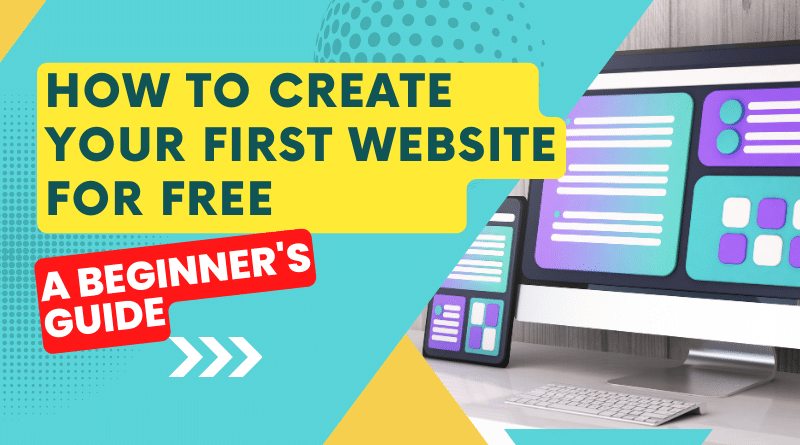How to Create a Website for Free: A Beginner’s Guide
Introduction: In today’s digital age, having a website is essential for individuals, businesses, and organizations to establish an online presence and reach a wider audience. The good news is that creating a website no longer requires a hefty budget or advanced technical skills. In this guide, we’ll walk you through the step-by-step process of creating a website for free, empowering you to share your ideas, products, or services with the world without breaking the bank.
Choose a Free Website Builder: The first step in creating a website for free is to choose a website builder that offers a free plan. There are several user-friendly platforms available, such as Wix, Weebly, WordPress.com, and Google Sites, that allow you to build and customize websites without any coding knowledge.
When selecting a website builder, consider factors such as ease of use, available features, customization options, and scalability. Look for platforms that offer intuitive drag-and-drop editors, a wide range of templates, and robust support resources to help you get started.
Sign Up and Select a Template: Once you’ve chosen a website builder, sign up for a free account and explore its collection of templates. Choose a template that aligns with your vision for your website, whether it’s a personal blog, portfolio, online store, or business website.
Templates serve as a starting point for your website design, providing pre-designed layouts and styles that you can customize to suit your preferences. Browse through the available options and select a template that reflects the look and feel you want to achieve for your site.
Customize Your Design: With your chosen template in hand, use the website builder’s drag-and-drop editor to customize your website’s design. This intuitive tool allows you to modify various elements of your site, such as fonts, colors, layouts, and images, without any coding required.
Personalize your website by adding your own images, text, and branding elements to make it uniquely yours. Incorporate your logo, brand colors, and other visual elements to create a cohesive and professional-looking design that resonates with your audience.
Add Content: Next, populate your website with content to inform and engage your visitors. Create pages for different sections of your site, such as an About Me/Us page, Services or Products page, Contact page, and any other relevant sections.
When writing content for your website, focus on providing valuable information that addresses your audience’s needs and interests. Use clear and concise language to communicate your message effectively, and incorporate relevant keywords to improve your site’s visibility in search engine results.
Optimize for SEO: Optimizing your website for search engines is crucial for improving its visibility and attracting organic traffic. Conduct keyword research to identify relevant keywords and phrases related to your niche, and incorporate them strategically into your website’s content.
Use keywords in your page titles, headings, and body content, as well as in meta tags and descriptions, to help search engines understand the relevance of your website to user queries. Additionally, optimize your images with descriptive filenames and alt text to improve accessibility and SEO.
Preview and Test: Before publishing your website, take the time to preview and test it across different devices and web browsers to ensure that it looks and functions as intended. Check for any formatting issues, broken links, or other errors that may detract from the user experience.
Test your website’s navigation, functionality, and load times to ensure a seamless browsing experience for visitors. Make adjustments as needed to address any issues and optimize your site for maximum usability and performance.
Go Live: Once you’re satisfied with your website’s design and content, it’s time to publish it to the web. Most free website builders offer one-click publishing options that make it easy to go live with your site.
Before launching your website, take the time to review your settings and configurations to ensure that everything is set up correctly. Double-check your domain name, site title, and other essential details to avoid any last-minute surprises.
Additional Tips:
- Utilize Blogging Features: Many website builders offer built-in blogging features, allowing you to easily start a blog section on your website. Blogging is an excellent way to regularly publish fresh, informative content related to your niche, attracting visitors and improving your site’s SEO.
When creating blog posts, focus on topics that resonate with your target audience and provide value. Write engaging, well-researched content that addresses common questions, challenges, or interests within your industry.
Optimize your blog posts for search engines by incorporating relevant keywords and phrases naturally throughout your content. Use descriptive headings, meta tags, and alt text for images to improve your posts’ visibility in search engine results.
- Integrate Social Media: Incorporating social media into your website can help you expand your reach and engage with your audience on multiple platforms. Add social sharing buttons to your blog posts and other content to make it easy for visitors to share your content with their networks.
Additionally, include links to your social media profiles on your website, allowing visitors to connect with you on platforms like Facebook, Twitter, Instagram, and LinkedIn. Encourage visitors to follow you on social media to stay updated on your latest news, promotions, and content.
- Monitor Analytics: Tracking your website’s performance is essential for identifying areas of improvement and optimizing your site for success. Utilize website analytics tools to monitor key metrics such as traffic sources, page views, bounce rate, and conversion rates.
Google Analytics is a popular choice for tracking website performance, offering detailed insights into your audience’s behavior and interactions with your site. Use this data to identify trends, understand your audience’s preferences, and make informed decisions to enhance your website’s effectiveness.
Regularly review your analytics reports to identify areas for improvement and track your progress over time. Experiment with different strategies and tactics to see what works best for your website and audience, and adjust your approach accordingly.
- Regularly Update and Maintain: Keeping your website fresh and up-to-date is essential for maintaining its relevance and effectiveness over time. Regularly update your content, images, and other elements to ensure that your website remains engaging and informative for visitors.
Schedule regular maintenance tasks, such as checking for broken links, updating plugins or extensions, and optimizing images and other media files. Regular maintenance helps ensure that your website continues to perform well and provides a positive user experience for visitors.
By staying proactive and investing time and effort into your website’s upkeep, you can maximize its impact and effectiveness in achieving your goals. Remember that building and maintaining a successful website is an ongoing process, so stay committed to continuous improvement and optimization.
Conclusion: Creating a website for free is easier than ever, thanks to the availability of user-friendly website builders. By following this beginner’s guide, you can create a professional-looking website that effectively showcases your ideas, products, or services without spending a dime.
Don’t let a limited budget hold you back—start building your free website today and join the online community!




